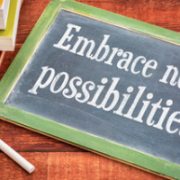Abstract Classical psychodrama embodies the theory and practice of spontaneity and creativity as the goal of all methods of change. In today’s world of post-traumatic growth (PTG), this is a perfect match for the view of humans as resilient and always seeking growth, even following traumatic and often violent experiences. This article of the Zeitschrift für Psychodrama und Soziometrie details the Therapeutic Spiral Model (TSM), which is a trauma-informed, stage-process model to change the self-organization of people affected by trauma by using experiential methods. TSM presents the first internal role map for working with parts of self, developed through decades of clinical observation (Hudgins 2017, 2002). TSM connects with advances in clinical psychology on trauma and attachment, and the latest research on interpersonal neurobiology, and makes a crucial turn from interpersonal work in psychodrama to the focus on inner parts of self. The trauma survivor’s internal role atom (TSIRA) is presented as a three-stage model to guide all action methods when working with parts of self that include: Prescriptive (RX) roles, the TSM Trauma Triangle, and roles of transformation and post-traumatic growth (PTG). Composite examples are given from a lifetime practice in the global community to help bring the clinical structure of the internal role atom to life for inner parts work.
Tag Archive for: Trauma
By Scott Giacomucci & Joshua Marquit
Results demonstrated over 25% decrease in PTSD symptoms for participants in Mirmont’s “Phoenix/Trauma Group” which is based on trauma-focused psychodrama. Considering the average patient only attended the group 4-5 times (2x per week), these results are quite meaningful and 2.5x the level of change in a residential trauma-focused CBT program with similar qualities.
This single group pretest-posttest study explores the effectiveness of trauma-focused psychodrama in the treatment of post-traumatic stress disorder (PTSD) at an inpatient addiction treatment center. The results contribute to the limited research bases of both psychodrama and PTSD treatment outcomes in inpatient addiction treatment. The present study supports the potential effectiveness of two trauma-focused psychodrama models, the Therapeutic Spiral Model and the Relational Trauma Repair Model. Findings of the research demonstrate clinically significant reductions in overall PTSD symptoms (over 25% change) and each PTSD symptom cluster (i.e., re-experiencing and intrusion, avoidance and numbing, and hyper-arousal). Additionally, patient satisfaction exit survey data support overall treatment effectiveness and highlight its tolerability, and capacity for establishing emotional safety, connection, and group cohesion. Patients even described the trauma-focused psychodrama treatment approach as enjoyable and helpful. Overall, the results of this study are promising, and support continued clinical application of trauma-focused psychodrama treatment with other subpopulations diagnosed with PTSD. However, the ability to isolate effects of trauma-focused psychodrama in this study is compromised due to the absence of a control group and participants’ involvement in other inpatient treatment services.
We are happy to announce the formation of two TSI International Training Groups in Experiential Trauma Therapy using the Therapeutic Spiral Model to treat trauma. Please join us as we start our new cohorts in Zagreb, Croatia in December, 2019, and in Philadelphia, PA, USA in February, 2020. You can become part of our TSM international community of like-minded people seeking to change how trauma work is done around the world.
The Therapeutic Spiral Model (TSM) is a 3-stage, process model of Experiential Trauma Therapy using clinically modified psychodrama interventions and additional action strategies from Gestalt therapy, Focusing, etc. TSM Psychodrama has research support showing that its use of spontaneity, creativity, and role theory to guide safe and effective psychodrama results in clinically significant changes in anxiety, depression and symptoms of PTSD. In these groups, we will continue our research on increases in spontaneity and post-traumatic growth.
Each cohort will provide the opportunity to meet the requirements of the Introduction to Theory Certification in Experiential Trauma Therapy
by summer 2020. Learn the neurobiology of trauma and why the latest research in neurobiology and attachment prescribed Experiential Therapy as the treatment of choice for trauma-related difficulties. Experience the safety of containment as you share your personal traumas as part of your training in TSM. Finally enjoy transforming your trauma triangle to one of personal recovery, empowerment, and connection to others.
In Zagreb, the group is conducted in English and we invite people of any nationality to join this group. It is already half subscribed so please sign up early. Learn more here: http://bit.ly/2I8o8iz
Philadelphia brings a rich opportunity to interact with senior TSM clinicians and trainers in our on-going cohort of 4 years. This diverse group of practitioners seek to bring TSM to their own private and professional settings. Learn more by contacting Dr. Kate at drkatetsi@ icloud.com
Get More Information on Our FB Group: https://www.facebook.com/groups/488289831993590/
Dr Kate will be joined by an international training Action Healing Team throughout the year.
Zagreb, Croatia:
- December 15, 2019- Neurobiology of Trauma
- March 22, 2020- Containment: The Key to Safety with Action Methods
- June 28, 2020- Making Friends with Defenses
Philadelphia, PA
- Feb 7, 2020- Brain in Action
- May 1, 2020 Making Friends with Defenses
- July 10-12 Transforming the TSM Trauma Triangle
Each workshop can be taken as a stand alone training or you can come to all and receive an International Certification in Experiential Trauma Therapy Theory in TSM Psychodrama
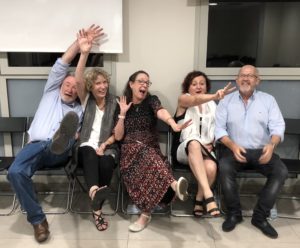
Photo: taken during a TSM psychodrama training in Madrid.
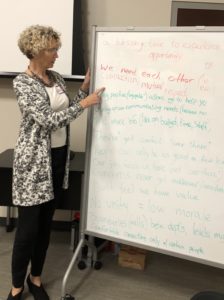
Differences are conversations waiting to happen. Talk to the “other side,” because it’s harder to hate up-close, as Michelle Obama says. Here’s two challenges I’d love to see newscasters, YouTubers, Facebookers, teachers and leaders take, and then post on social media for the rest of us to imitate:
– Every day, listen to a complete stranger for five whole minutes. In the check-out line, at the bus stop, at a game, wherever. Keep an open mind; repeat what they said as if you believed it — even if just for those five minutes. That’s called “mirroring” or “doubling” someone.
– Sort for similarities, not differences. In any conversation, challenge yourself to silently list at least 5 beliefs or attributes you have in common. If you train your brain to sort for commonalities, you’ll notice more of them.
I had the pleasure to interview Andrea C Hummel. Andrea is trained in multicultural diversity, mediation and trauma recovery. She holds a Masters in applied anthropology with additional studies in intercultural conflict mediation. She’s also trained in multi-track diplomacy and Shadow Work® and holds a theory certification in TSM psychodrama for post-traumatic growth. Her study of ten languages helps her connect with audiences when presenting at conferences both in the US and abroad. No stranger to staying focused during crisis, Andrea was in the Middle East during the 1990 Kuwaiti oil crisis, Guatemala during the 1995 refugee persecutions, and Greece during the 2015 refugee crisis. In 1991 Andrea founded a consulting firm specializing in cultural diversity. She was also an adjunct faculty member at University of Florida and Manatee Community College. Initially her focus was on preventing conflict (via cultural understanding); now it’s on resolving conflict (via facilitated improvisations). She’s the developer of the cutting-edge peacedramas for helping individuals and communities increase empathy, decrease miscommunication and create alternate endings to historical conflict. She’s worked with the Micosukee Tribe of Indians, Recover!Charlottesville, US Navy STRICOM, AmeriCorps, Equifax, and state and local government agencies. Co-author of an Amazon #1 bestseller on women overcoming hardship, Andrea is currently writing a self-help book on post-traumatic growth with trauma expert Kate Hudgins.
Thank you so much for joining us Andrea! Can you tell us a story about what brought you to this specific career path?
Growing up bicultural, I wondered why I felt “different” and didn’t fit in anywhere. Studying anthropology helped me understand there are many shades and colors of values, behaviors and ways of viewing the world — even though underneath it we’re all humans. I spent years teaching cultural diversity workshops, and then learned about experiential work. I started leading group simulations so people could experience what it felt like to be an “outsider.” Then in the late 1990s a friend persuaded me to attend a Shadow Work® weekend out in Colorado, where we healed personal shadows through acting them out. It was eye-opening: the whole idea that we have parts of ourselves that we hide away and then proceed to get tripped up by. That’s why I pursued training in psychodrama, which is acting out your stories for personal growth.
Another influence was hearing family stories about growing up in Europe during World War II. My parents experienced living in daily fear and with little food in a country whose people were turning against each other. My grandfather in particular stood up for his beliefs against the prevailing government in a socio-political climate similar to what we see in the US and the world today: scapegoating, bigotry and rejection of anyone “different.” He paid for his activism with his life, as did countless others…So I feel a need to continue what he started all those years ago.
Can you share the most interesting story that happened to you, since you began leading your company?
This is a great example of the fear and divisiveness in our country at the moment. Like most of us, I was watching the 2016 election closely, on the edge of my seat about who’d be our next president and what that would mean for the social fabric of our country. When the results came in the next morning, and so many people felt devastated, the mood in Washington DC (where I live) was somber. Everywhere I went that day, people looked in shock. I had a jumble of disjointed feelings inside too; I just had to do something. So I got several bouquets of flowers. I stood on a street corner with a sign reading “I’m committing a random act of kindness,” and handed out a flower to every person walking by. It was amazing — and interesting — to see the looks on people’s faces at getting a rose: mostly relief, smiles, and a few people even crying. That simple gesture of me, a complete stranger, connecting with them was what broke through their shock and sadness. Several passers-by stopped to share stories (“I interviewed Hillary just last night, so this is hitting me hard,” or “I voted for Trump, but I’m taking this flower home to my mom who’s a Democrat.”) It showed me how hungry Americans are for connecting, talking, reaching out, being understood — they just don’t know how. And now, in the current social climate, they’re afraid to. It makes me even more passionate about doing the work I do.
Can you share a story about the funniest mistake you made when you were first starting? Can you tell us what lesson you learned from that?
When I was starting out years ago, I didn’t know how to do an effective sales pitch. I remember talking to the police chief of a small Southern college, who was looking for sensitivity training for his officers. I laid out all the benefits, named other organizations I’d trained, and rattled off demographics and statistics. The chief nodded and asked a lot of questions, so I thought I’d sealed the deal. We shook hands, I got up to go and walked toward the door. Then I suddenly realized I hadn’t told him my fee. With my hand on the doorknob, I turned around and named a figure, then left quickly. Oh boy! Big mistake! He had no chance to ask questions or negotiate…Needless to say, I didn’t get the contract.
What I learned from that is: Know your own worth and own it. Be confident that what you have to offer the world is worth what you’re asking. That applies to both work as well as personal gifts of our time, caring, listening, etc. that we offer to those around us daily.
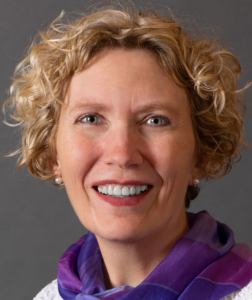
Can you describe how your organization is making a significant social impact?
Every conversation, every workshop, makes a difference in healing social wounds. We can’t solve society’s problems in one day. After all, Rome wasn’t built in a day, and it would be rather monochrome if it were… But what we can do is create pockets of change throughout our towns. The people in those pockets will influence others, be more open with strangers, even organize events to get to know “the others.” They can have the optimism to elect leaders who are likewise positive and working to bridge differences. One of my favorite quotes is by fellow anthropologist Margaret Mead: “Never doubt that a small group of thoughtful committed people can change the world. Indeed, it’s the only thing that ever has.”
I’ve also seen how even one of our projects two years ago in Charlottesville impacted not only the community who participated there; it also led to a second project with a group of therapists, who in turn helped their many clients, whose families and workplaces were hopefully also impacted by the empowering healing techniques we taught them. And it then led to further projects with nearby municipalities and their employees. So the social impact is a ripple effect of helping individuals in communities heal after violence and miscommunication, who pay it forward by trusting others more.
Wow! Can you tell me a story about a particular individual who was impacted by this cause?
When we started our work in Charlottesville, most people the team talked to were traumatized by the events of the 2017 white supremacist march. They were tense, emotional, fearful of leaving their homes, and hesitant to return downtown (where the violence occurred). One man in particular (with whom I later became friends) had a hard time finding meaning in his work, ended a significant relationship immediately afterwards, and stopped talking to strangers. After participating in our six months of community workshops, he said he’d had the catharsis he needed, felt more connected into the community, and was motivated to start additional community events to keep the conversations going. It opened his mind to seeing others through their eyes (instead of his own), and being more open to them even if he didn’t accept certain of their viewpoints. Those are the success stories I like to hear!
Are there three things the community/society/politicians can do to help address the root of the problem you are trying to solve?
Social change begins at the community level — but leaders create the structure and role-modeling to motivate the rest of us. Several things leaders can do are:
- Model “reaching across the aisle” and listening to those different from themselves. Model placing the well-being of the community/country ahead of that of the individual (such as getting re-elected to office).
- Demonstrate acceptance of strangers; don’t be a xenophobe. Reflect this in policies they sponsor. Look for solutions that aren’t black-and-white, such as expelling all foreigners and building a wall. Instead, support capacity-building in other countries, reducing the need for citizens to immigrate to the US.
- Organize local “meet-and-greets” with various ethnic, religious and political groups within communities. Remember that differences are just conversations waiting to happen. Sponsor quarterly community reconciliation forums to work through the hurt, fear and anger. In other words: create opportunities for acting out the change we want to see in the world, to paraphrase Gandhi.
How do you define “Leadership”? Can you explain what you mean?
It’s not about self-aggrandizement but the glory of the TEAM. A good leader inspires his/her team, listens to their personal concerns (really connects with them), and sees them as people and not just producers/automatons. True leaders are passionate about the organization’s mission and motivate others to follow. They are part cheerleader, counselor, coach and goal-setter. They are willing to be a voice for people who can’t or won’t speak up for themselves. (That last criteria is courtesy of my daughter, who’s thankfully good at speaking up.)

What are your “five things I wish someone told me when I first started” and why?
- You’ve got to plant a lot of seeds before you see results. Be patient; it takes time to start a social movement. Several people I met decades ago are now coming back asking for workshops. Part of it is the greater need for social repair these days; the rest is people being more connected through social media.
- It’s hard work. You’ve got to keep up your belief in what you’re doing. If you get burned out, take a break from the sad traumatic parts: pitch a tent in your living room or foster puppies. — Yes, I’ve done both.
- You need a team. Big things can’t be accomplished alone. Despite what my mother said, the best helping hand is at the end of your arm…AND many other willing people’s arms! I wish I had the space here to name all the caring, interesting and even irritating people who’ve helped me along the way…especially when I was flying blind.
- You’ll spend a lot of time educating decision-makers — to explain the need for your services. I’ve noticed that a live demonstration of peacedramas at conferences really helps leaders make the decision. And videos show a lot that can’t be explained with statistics or words.
- There are multiple ways to get the job done. If you can’t “save the world,” then become a secretary (or other support) for someone who can. When I was growing up, I wanted to be a translator for the UN. Then I admired people like Jimmy Carter, Rosa Parks, Michelle Obama — anyone who made a difference without thinking of themselves. And now I believe I can impact society just by listening to people different from me, and inspiring others to do the same.
You are a person of enormous influence. If you could inspire a movement that would bring the most amount of good to the most amount of people, what would it be? You never know what your idea can trigger.
Differences are conversations waiting to happen. Talk to the “other side,” because it’s harder to hate up-close, as Michelle Obama says. Here’s two challenges I’d love to see newscasters, YouTubers, Facebookers, teachers and leaders take, and then post on social media for the rest of us to imitate:
– Every day, listen to a complete stranger for five whole minutes. In the check-out line, at the bus stop, at a game, wherever. Keep an open mind; repeat what they said as if you believed it — even if just for those five minutes. That’s called “mirroring” or “doubling” someone.
– Sort for similarities, not differences. In any conversation, challenge yourself to silently list at least 5 beliefs or attributes you have in common. If you train your brain to sort for commonalities, you’ll notice more of them.
Can you please give us your favorite “Life Lesson Quote”? Can you share how it was relevant to you in your life?
Fred Rogers said: “When I was a boy and would see scary things in the news, my mother would say, ‘Look for the helpers. You will always find people who are helping.’”
In other words, you see what you look for. That goes hand-in-hand with my mantra that a positive attitude produces positive change. I read Mr Rogers’ quote only a few years ago, at a time when I was overwhelmed by the negativity, violence and organized hatred in the world. I was close to throwing in the proverbial towel and finding a less stressful career. But since then, I’ve chosen to focus on the helpers in the world, those who cut through the chaos to simply be present, listen and do their best for that one person next to them. That’s all we can ever do. I really believe that’s what makes the difference in today’s world.
Is there a person in the world, or in the US, with whom you would love to have a private breakfast or lunch, and why? He or she might just see this, especially if we tag them. ☺
I actually have three favorite people:
Andrea Mitchell “reached across the aisle” in her own home: she’s a Democratic journalist married to a Republican former chairman of the Federal Reserve. If she can do it (while in the public spotlight, no less), so can the rest of us. Her reporting has always been intelligent and insightful…And she shares my first name.
Jimmy and Rosalyn Carter have continued their activism, consulting and community support even after they left the White House. Mr Carter was the first president I followed as a young teen, and he gave me hope that presidents can inspire positive change. Both he and Mrs Carter have made perhaps more of an impact on the national and world stage in the past decades than in their four years in Washington.
Michelle Obama personified the quote “When they go low, we go high.” She didn’t contribute to the rising negativity and divisiveness in our society. Also, she was gracious in her role as ground-breaking African-American First Lady and is inspirational as a highly-educated and accomplished woman who was able to balance career and family.
How can our readers follow you on social media?
www.improvforpeace.com
https://www.facebook.com/improvforpeace/
https://twitter.com/andreachc3
https://www.linkedin.com/in/andreahummel/
This was very meaningful, thank you so much!
Article originally posted on Medium.com
There can be positive change after adversity.
By Adena Bank Lees, LCSW
For those who have experienced trauma, it is common to feel like life will never be the same again. As evidenced by a growing body of research, though, humans have the ability to not only “bounce back” from trauma, but to yield a positive life on the other side of a traumatic experience. Those who study and practice in the field of mental health refer to this as posttraumatic growth (PTG), defined as positive psychological change experienced as a result of adversity and other challenges in order to rise to a higher level of functioning.
About Posttraumatic Growth
The general concept that trauma can lead to positive change is a common theme that has appeared in religious and philosophical teachings for thousands of years, but it wasn’t until the mid-1990s that the term posttraumatic growth was coined by psychologists Richard Tedeschi and Lawrence Calhoun.
Tedeschi and Calhoun posit that PTG tends to occur in five general areas:
- Appreciation of life
- Relationship with others
- New possibilities in life
- Personal strength
- Spiritual change
These five factors make up the general themes of the Posttraumatic Growth Inventory (PTGI), a 21-item assessment tool developed by Tedeschi and Calhoun to determine an individual’s progress in reconstructing their perceptions of self, others, and the meaning of events while they are coping with the aftermath of trauma. PTG does not discount those who struggle with posttraumatic stress. It does, however, offer a new lens through which an individual can explore themselves in the shadows of trauma.
Experiential Methods Can Encourage Posttraumatic Growth
As practitioners, we must meet our clients where they are at and not minimize their suffering by jumping to practical solutions. Most often, our assistance is sought after a traumatic event has occurred, so we need to take great care in introducing PTG concepts. Therapy – especially when experiential learning methods are employed – can help people see that things like these are true for them:
- I discovered that I’m stronger than I thought I was.
- I know better that I can handle difficulties.
- I changed my priorities about what is important in life.
Experiential learning allows healing to take place in “real time” – we do not talk about something, we actually engage in it.
Take Christine (35 years old), for example, who was sexually abused from ages 8-13. Christine felt alone and did not trust others when she entered therapy. In several psychodrama group therapy sessions, Christine experienced group members’ support through their standing behind her with hands on her shoulders. She allowed hugs when crying or frightened. Group members contacted her between sessions to see how she was doing. At the close of the 12-week commitment, Christine reported, “because my group members were here for me and supported me when I was crying and in pain, I am more trusting that I can count on others in difficult times.” She continued with the group and strengthened the relationship aspect along with other aspects of PTG.
According to Dr. Kate Hudgins, co-founder of the Therapeutic Spiral Model, “Posttraumatic Stress Disorder is not a terminal illness. It can be treated with experiential methods such as those from the Therapeutic Spiral Model of psychodrama, which addresses trauma in action. As clients build up the strength to face their trauma, they realize that they can emerge victorious into PTG.”
Therapist, author, and lecturer Rokelle Lerner recommends using story writing as an experiential strategy to identify, clarify and solidify posttraumatic growth: “Every time we describe our life’s events, we are both providing and discovering underlying patterns of meaning. It is the meaning we make of our experience that shapes how we feel, think, and respond.” Lerner offers the following outline for writing one’s story:
- Once upon a time… (wounding)
- And when he/she grew up… (present)
- The story changed when… (vision)
At the very least, we can help clients understand that posttraumatic growth is a normal process that can be a possibility for them.
References
Tedeshi, R.G., & Calhoun, L.G. (2004). Posttraumatic Growth: Conceptual Foundation and Empirical Evidence. Philadelphia, PA: Lawrence Erlbaum Associates.
Tedeschi, R. G., & Calhoun, L.G. (1996). The Posttraumatic Growth Inventory: Measuring the positive legacy of trauma. Journal of Traumatic Stress, 9, 455-471.
Tedeschi, R.,et al, (2018). Post Traumatic Growth: Theory, Research and Applications. New York, NY: Routledge.
Article originally posted on Psychologytoday.com
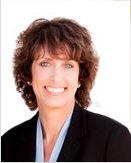 Adena Bank Lees, LCSW, is a counselor, speaker, author, and consultant, providing fresh perspective on traumatic stress, addiction treatment and recovery. Her specialty is childhood sexual abuse, and in particular, Covert Emotional Incest. She is a Licensed Clinical Social Worker, Licensed Independent Substance Abuse Counselor, Board Certified Expert in Traumatic Stress ®, and a Certified Practitioner of Psychodrama. She is the author of Covert Emotional Incest: The Hidden Sexual Abuse, A Story of Hope and Healing, as well as 12 Healing Steps for Adult Survivors of Childhood Sexual Abuse; A Practical Guide.
Adena Bank Lees, LCSW, is a counselor, speaker, author, and consultant, providing fresh perspective on traumatic stress, addiction treatment and recovery. Her specialty is childhood sexual abuse, and in particular, Covert Emotional Incest. She is a Licensed Clinical Social Worker, Licensed Independent Substance Abuse Counselor, Board Certified Expert in Traumatic Stress ®, and a Certified Practitioner of Psychodrama. She is the author of Covert Emotional Incest: The Hidden Sexual Abuse, A Story of Hope and Healing, as well as 12 Healing Steps for Adult Survivors of Childhood Sexual Abuse; A Practical Guide.
Hello All you Lovely Psychodramatists.
Dr. Kate has asked me to write a blurb about the TSM training I have been offering in Ottawa, Ontario, CANADA over the past three years. It started off as something organic and has evolved into four modules, each one containing 8 sessions. It is a closed group of trainees who meet for 3 hours once a month for 8 sessions. This completes one module in the International Certification in Experiential Therapy Using the Therapeutic Spiral Model.
The first module is focused on Prescriptive (RX) roles, teaching all the safety structures, doing small vignettes, and small group exercises that give people an opportunity to practice observing ego, containing double, body double, restorative roles. Participants learn to use the Trauma Survivor’s Internal Role Atom (TSIRA) to build the spontaneity and creativity needed to work with trauma for themselves and their clients.
The second module is 8 sessions of learning about the three different types of defenses, ie. Survival defenses, addictions, obsessions and compulsions. We make sure to have fun as we create different ways of exploring the group’s own defenses. Then the last prescriptive role is introduced, the Manager of Defenses, and the group has opportunity to be creative in producing their own manager of defenses in self presentations. This series ends with a prescriptive role drama.
The third module is 8 sessions directing and participating in full trauma dramas where transformative roles are introduced. The group meets the Sleeping Awakening Child, the Good Enough Mother, Father, Spirituality. More seasoned group members have opportunity to direct full dramas, while newer group members become more skilled as auxiliaries, deepening their learning in prescriptive roles, taking on trauma- based roles of Victim, Perpetrator and Abandoning Authority and Roles of Transformation, as mentioned above.
The last module is 8 sessions on transformation. September 2019 will be the first 8 sessions of the last module so stay tuned!
Each series gives an opportunity to take in new group members and allow for successful departures. Currently we have 10 group members, 4 of whom are more seasoned and 6 who are new to the model. At the end of each 8 session series I invite the Master and Creator of TSM, Dr. Kate herself, to come and co-lead a client group where trainees have opportunity to participate on the team and have in vivo supervision while practicing their skills with a client based group.
This leads me to tell you about the upcoming May, 2019 Personal Growth Workshop on Boundaries. (see TSI calendar at www.therapeuticspirslmodel.com for info and registration). Since 2001 I have been bringing Dr. Kate to Ottawa to lead or co-lead personal growth TSM workshops. All though the theme is always post traumatic growth, we often like to focus on a particular areaof growth. This May the focus will be on boundaries…. Where I Begin and You End. May 24, 25 and 26th, 2019. We sure hope to see you there! Contact: Monica Forst, 613-823-3848 or monforst@gmail.com. Fee: $550.00 Cdn. Early bird. $600. Regular. Lunch included.
This workshop culminates the third module of the training series, where the training group will have just completed their 8 sessions on trauma dramas and many of them share their skills as Action Healing Team Members.
A Note from Monica Forst, TSI Trainer, Ottawa Canada
The TSM Six Safety Action Structures have been developed and used to concretize spontaneity and provide containment and group cohesion for all Therapeutic Spiral Model (TSM) groups for several decades now (Hudgins & Toscani, 2013). The original paper on these safety structures (Cox, 2001) is available on my website at www.drkatehudgins.com. This handout is an expansion on the original use of the structures with examples of how they can be used in individual, couples, group and family therapy, as well as in communities and organizations. At the workshop, they are presented in action just as they would be used to start a TSM group in any of the above settings. Read more
ARCHIVES
- January 2021
- November 2020
- August 2020
- July 2020
- April 2020
- March 2020
- January 2020
- September 2019
- August 2019
- July 2019
- June 2019
- May 2019
- April 2019
- February 2019
- January 2019
- October 2018
- July 2018
- June 2018
- May 2018
- April 2018
- March 2018
- February 2018
- January 2018
- December 2017
- September 2017
- August 2017
- July 2017
- June 2017
- May 2017
- April 2017
- March 2017
- February 2017
- November 2016
- October 2016
- August 2016
- July 2016
- June 2016
- April 2016
- March 2016
- January 2016
- December 2015
- November 2015
- July 2015
PAGES
- Home
- MEET THE TSI TRAINERS AND TEAM MEMBERS
- LINDA CIOTOLA, M.ED., TEP
- Mario Cossa, RDT/MT, TEP, CAWT
- Axel Eichel, M.Sc., TSI Trainer, HP Psychotherapy
- Monica Forst, Registered Psychotherapist, M.Ed., I.C.A.D.C., C.C.C.
- Kate Hudgins, Ph.D., TEP
- Sylvia Israel, LMFT, RDT/BCT, TEP
- Ben Rivers, PhD, RDT, APTT
- FRANCESCA TOSCANI, M.ED., TEP
- Vlada Zapesotsky, Ph.D., PAT
- TSI Calendar
- Certification Process
- Connecting With Us
- The Therapeutic Spiral Model
- Video Gallery
- Blog
- Resources
- Research


